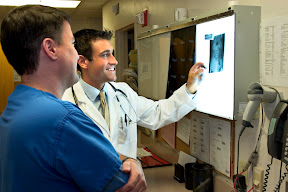Diagnosing Health Care Leadership Development
To succeed in today’s health care field, its leaders must develop better innovative learning strategies to communicate a compelling vision of high-quality, cost-effective care
Combining medical technology and human expertise, the health care industry administers care and diagnoses and treats problems around the clock, responding to the needs of millions of people. To do this effectively, the Bureau of Labor Statistics estimates approximately 596,000 organizations employ 14.3 million wage and salary workers. But while this means one in 11 U.S. residents is employed in health care, one in seven new hires in the industry leaves his or her job within their first year.
“Health care recruiters are rewarded for speed and cost,” said Kim Lamoureux, senior director of research practices and principal analyst of talent acquisition for Bersin & Associates. “Everything with a hospital is about cost savings, and positions need to be filled quickly. When those are your two primary drivers, you tend to bring in people very quickly that meet minimum standards and you’re not really looking for top talent, emerging leaders — you don’t have the luxury of time.”
Lamoureux believes that it is the learning organization’s role to fill gaps quickly to make sure employees do not leave because they’re not engaged or the right fit. To do this, chief learning officers have to collaborate with other talent management leaders to better understand progression and what skills are transferable, as well as think of development in the context of career development, not just current position development.
“Often someone takes an assessment and they’re hired because they passed this test,” Lamoureux said. “That assessment also identifies where their professional holes are on the first day of the job. Learning leaders should be looking to fill those gaps with instantaneous, on-demand development opportunities. Health care leaders are highly innovative on things they need to be innovative on, which is the welfare of their patients, which is good, but they’re not nearly as innovative when it comes to really thinking about how to develop and select their people.”
Some of this is due to the competitive nature of the industry, according to Lamoureux. She said health care providers are afraid to be too social and thus do not realize the power of learning from their peers, learning best practices and how they should be applied to different hospitals. Each hospital has its own culture and is afraid of fracturing it, so any development that occurs is formal and slow. Since one of health care’s biggest challenges is limited time for development, employee growth is stunted.
“For the past 30 years, health care leaders have had their heads down, really focusing on expertise and specialization to beat the competition and improve medicine, without taking a step back to understand the business [and the] operational capabilities of the industry,” said Justin Holland, managing principal of strategy and leadership for GE Healthcare Performance Solutions. “It’s a challenge, but [also] an opportunity to tap into these great leaders in the hospital and make sure they understand the key tenets to running multibillion-dollar organizations; issues around being able to recruit, develop and retain staff [and] improve and grow their own careers.”
In August, GE Healthcare Performance Solutions, a unit of GE Healthcare, noticed this gap and introduced two online, interactive assessment tools for aspiring health care executives to assess their leadership skills and for C-suite level executives to identify ways to better support the development of future leaders. The Aspiring Executives Tool identifies six factors considered critical to an individual’s leadership advancement, developing objective ratings in each area. Once completed, the tool provides results highlighting areas to focus development, prompting dialogue regarding career advancement and the skills necessary to be an effective leader. The Executive and Talent Development Staff Tool, meanwhile, assesses an organization’s current efforts to foster the development of its next generation of leaders and offers actionable recommendations to improve leadership development practices.
“For leadership development in health care organizations to be successful, learning has to be action learning connected to real work on real projects,” Holland said. “It needs to be tied directly to the organization’s needs and help to improve the individual and the business. Technology in the health care industry is evolving and advancing. Its business counterpart and leaders have to keep up.”


No comments:
Post a Comment